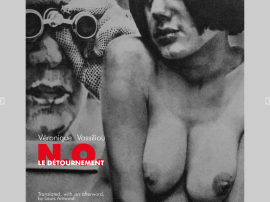VLAK ITINERARIES’ inaugural publication: N.O. LE DÉTOURNEMENT by Véronique Vassiliou, translated, with an afterword, by Louis Armand.
DOWNLOAD N.O. Le Detournement (PDF)
N.O. le détournement by Véronique Vassiliou is a meandering, fragmentary, hybrid work. It was initially commissioned as a dialogue for a film about French photographer and painter Gérard Gasiorowski, whose later work constituted a variety of fictive art pieces criticising the art world and investigating the nature and function of art. These pieces were not simply photos or paintings, but a fake art school, an imaginary primitive artist named Kiga, and one project with which he was so obsessed that (in his own account) his wife left him.
Taken together Gasiorowski’s oeuvre took many variegated turns, exploring different media, scales, and styles. Similarly, Vassiliou employs many styles, from her own fictive quotes and dialogues, to lists, indexes, letters, etymologies, multiple choice, digressions, organised spatially, in different fonts and sizes, and in two columns, sometimes reminiscent of Derrida’s Glass or some parts of Finnegans Wake. They are all clues whose “illogical succession becom[e] the deployment of the enigma in advance of its resolution” (Vassiliou’s postscript; p. 71).
Thus, more than just describe these self-reflexive and drifting qualities, Vassiliou’s N.O. le détournement itself also enacts its very subject matter, performing various turns in dissipating directions, and shifts that fold back into themselves. Gasiorowski’s critical reflections on art set the stage for an analogous interrogation of poetry, not merely described and explained, but itself enacted and emergent. A stage, after all, is not an empty, abstract space, but “a tangible, physical place that needs to be filled & it ought to be allowed to speak its own concrete language” (reads the book’s motto, a quote by Antonin Artaud). A description of poetry, via art, thus becomes poetry, emerging as a poïesis, “in the generative tensions brought-forth by a language, a syntax, a general textual arrangement that demands thinking; that calls reason into being through a proto-typical act of writing that verges on the impossible.” (writes Armand in his lengthy afterword, which is more of a critical paper than a brief postscript; offering a rigorous, insightful account of this text; incidentally, this essay was previously published in VLAK 1 which is also available online; p. 79).
As Armand eloquently states, “…N.O. engages with the ambiguities that must arise within any form of critical discourse that seeks to locate, outside itself, a type of objective coordinate.” (79). Granted, the ambiguities of this constellation might be shared by more generally by certain types of discourse; but in N.O. le détournement they certainly find a most specific and singular iteration, accepting Gasiorowski’s “pictorial suicide” (76) and transforming this into a “local logic” (77) of détournement. The film about Gasiorowski was, fittingly, never completed. “The exercise must be continued until it starts to burn” (8)… Fire also requires a structure” (59). Some lists and clues (in single margin, mainly because I do not understand WordPress, entschuldigung…):
“N.O. Two letters inscribed on a scrap of paper. Two letters awkwardly traced, dribbled rather, bleeding through the paper (1)… N.O. is also noh, drama, lyricism and Japan. It is religion, tradition, rite, whitened figures whose gestures succeed one another in fits and starts in an ever repeating order. And it is the waki, the one who observes and recounts, who doesn’t perform, who takes no part in the story, who remains in the margin (12)… N.O. is also number, No, the symbol of enumeration, of the series (13)… N.O. is nihil obstat, that which permits whatever is permissible, which authorises and prevents, the frame and its limits, the constraint. That which is before being imprinted, before being given to be read (17)… N.O. meaning Nô, that is a basin. Perhaps it was a lake. It’s shallow, barely encrusted. Hollowed out by diluvian rains, and then by more rain, and still more (45)… N.O., which has six possible facets without any link between them (46)… And N.O. means no, means refusal, what won’t resign itself, what struggles and searches, it means escape, death and what dies, it means the margin, again, and what is at stake there. What cannot be resolved” (64)
I (scratched) am (scratched)
speak (scratched) do
(scratched) make (scratched)
some (scratched) make
(scratched) I assemble some
(scratched) these are the
sequences (scratched) some
pieces (scratched) these are
some stanzas (scratched) these
are some stances (67)
Apple, Apple, Apple, Apple,
Apple, Apple, Apple, Apple,
Apple, Apple, Apple, Apple,
Apple.”
AGAIN A CLUE (34)
I was the observer, in the
margins. The one who seeks
out, the one who encircles. (36)
“SHE is elsewhere. I’ll search for her again and again. I know that SHE is hiding there, inside the quest.”
ABSENCE OF ANY CLUE
(THE VOID) (35)
“SHE’s always out of place. Apart. On the fringes. In the wilderness”
CLUES (SHE) (51)
“I couldn’t have done without silence.
Lots of silence.”
FIFTY-SEVENTH CLUE (60)
– – –
HOVER HERE TO READ / DOWNLOAD N.O. LE DETOURNEMENT
Jeroen Nieuwland
December 24, 2013

